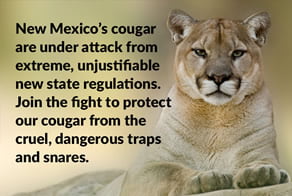Trapping Overview
Traps are inherently indiscriminate, capturing those not intended for the trap, including endangered animals, pets and people, and can leave permanent physical damage to anything that gets caught.
Coyotes and skunks can be trapped year-round without a license, so traps are placed in New Mexico year-round.
A 2005 statewide survey of New Mexicans revealed that sixty-three percent of New Mexico voters are against trapping on public lands and that fifty-nine percent of New Mexicans are unaware that trapping is legal on public lands or believe wrongly that trapping is illegal on public lands.
Arizona, Colorado, California and Washington have banned trapping on public lands.
Animals suffer pain, trauma and stress when held by traps, and immobilized animals can experience dehydration, hunger, panic-induced self-mutilation, exposure to weather and predation, all of which constitute animal cruelty.
New Mexico has conducted few wildlife population studies, and no one knows how many animals are actually being killed.
Traps cause injuries and stress for people and animals caught in their grip, including species that enjoy special protections. New Mexcio’s trapping management is haphazard, unscientific, and unjustified; reform is long overdue.
Trapping is legal on all public lands including national forest, BLM, and state land. It is restricted in Los Alamos County, Rio Grande Recreation Area in Taos, Valle Vidal Unit of the Carson National Forest, McGregor Military Range, and Valle Caldera National Preserve.
NMDGF has not established trapping zones, so heavily trapped subpopulations can be wiped out completely.
NMDGF has conducted few population studies on animals it allows to be trapped, the so called “furbearers”, species with fur of commercial value. Additionally, trapping kills, or so called harvest counts are woefully underreported. No one knows how many furbearers existed in the past or live in the present.
Reporting Compliance
While required to report their total cull to NMDGF each year, many trappers do not heed this rule. Trappers who fail to report avoid the consequence of being denied a trapping license the following year by paying an $8 late fee and submitting a tardy report. This calls into question the accuracy of such reports when they are turned in months after the fact. Even if accuracy is assumed, it insures that decisions about trapped animal populations and rules for the following season including a response to indications of harm cannot be made in a timely way.
As a result of this leniency, trappers have consistenetly failed to comply with the law; never exceeding a 79% compliance rate and coming in as low as 29%. Resident trappers pay a mere $20 for a license that allows unlimited killing of “protected furbearers” for months on end. There is also no way to check the veracity of the reports that are turned in. There are inherent incentives to under-report because of the desire to avoid taxes on the monetary gain and to not appear to be killing too many animals.
 Know Your NM State Legislators!
Know Your NM State Legislators!
Your New Mexico state Senator and Representative have the power to ban traps, snares and poisons on public lands. Find out who they are and let them know you oppose trapping on public lands. A simple phone call and email can make all the difference.
People's Forum Panel Report on Public Lands Trapping
The New Mexico Legislature should ban trapping on public lands in New Mexico because traps harm people, animal companions, and whole populations of wildlife including rare species. Most New Mexican voters believe that trapping is cruel and unnecessary.
TrapFree Friends
Animal Protection Voters
Black Bear Bureau
Footloose Montana
Fur Free Alliance
Furbearer Defenders
League of Humane Voters
Lobos of the Southwest
Mercy for Animals
National Urban Wildlife Coalition
No Cruel Traps on Public Lands
People's Forum Panel on New Mexico Public Lands Trapping
Predator Defense
Project Coyote
Pulling for Life
TrailSafe Nevada
Trap Free Montana
TrapFree Oregon
Wyoming Untrapped

